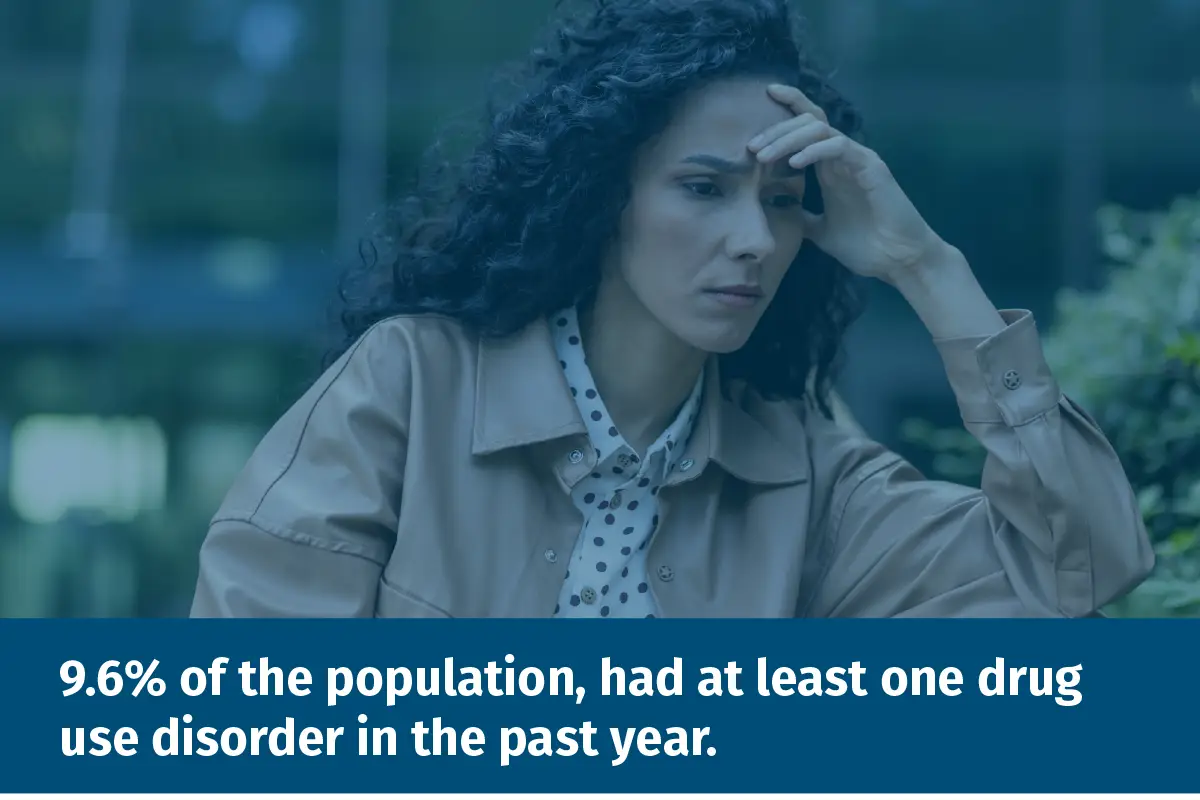Addiction Statistics 2024: Key Data Points And Trends
More Resources
Call us today to get the support and guidance you deserve.
Addiction in America: A Data-Driven Look at the Ongoing Crisis
Addiction remains a pressing public health concern in the United States, affecting millions of Americans from every walk of life. As we move through 2024, the impact of addiction, from opioid misuse to alcohol dependency, continues to shape our communities.
These issues affect individuals and strain families, workplaces, and the healthcare system. Understanding the latest addiction statistics is essential for grasping the full extent of this ongoing crisis. So, let’s delve into the most recent data on substance addiction.
Key Takeaways
Addiction remains a critical public health issue in the United States, affecting millions of individuals. Here is what this article covers:
- As per 2023 NSDUH, 48.5 million aged 12 or older experienced substance use disorders (SUDs) in the past year.
- Substance use disorders (SUDs) are prevalent, with specific rates varying by age group and substance type.
- About 4.5 percent of people with substance use disorders (SUDs) received treatment with varying methods
Most insurance plans cover treatment here, making the cost to you as low as possible - sometimes even zero.






Latest Addiction Statistics
According to the 2023 National Survey on Drug Use and Health (NSDUH), around 48.5 million people aged 12 or older, which is about 17.1 percent of the US population, experienced a substance use disorder (SUD) in the past year. This includes 28.9 million individuals with alcohol use disorders (AUDs) and 27.2 million of those with drug use disorders (DUDs).
The survey also reveals that a significant number of people face dual challenges. Among those with a past-year SUD, about one in six people, which is around 7.5 million individuals, had both an alcohol and a drug abuse disorder at the same time. This dual struggle makes it even harder for people to find the right help and effectively overcome their issues.
When looking at different demographic groups, the survey found that American Indian or Alaska Native people had the highest rate of SUD at 25.3 percent. Multiracial individuals followed at 24.3 percent, while White people were 17.8 percent. In contrast, Hispanic individuals had a lower rate of 15.7 percent, and Asian people had the lowest at 9.2 percent.
Alcohol use disorder (AUD) is a complex condition where a person cannot control their drinking and continues to drink despite negative consequences. As per 2023 NSDUH findings, 10.2 percent of people aged 12 or older, or about 28.9 million individuals, experienced AUD.
Among these, young adults aged 18 to 25 had the highest rates, with 15.1 percent or 5.1 million people affected. Adults aged 26 and older followed, with 10.3 percent or 23.0 million people. Adolescents aged 12 to 17 had the lowest rates, at 2.9 percent or 757,000 people.
The prevalence of alcohol abuse and addiction varied across different racial and ethnic groups across the country. Multiracial individuals had the highest rate at 13.6 percent, compared to Black people at 9.6 percent, Hispanic people at 9.2 percent, and Asian people at 5.7 percent.
Drug use disorder refers to the problematic use of illegal drugs or prescription medications, leading to significant impairment. As per 2023 NSDUH, 27.2 million people aged 12 or older, or about 9.6 percent of the population, had at least one drug use disorder in the past year.
Among these, 18 to 25 had the highest rates at 18.0 percent or 6.1 million people. Adults aged 26 and older had a rate of 8.6 percent, or 19.3 million people, while adolescents aged 12 to 17 had a rate of 6.9 percent, or 1.8 million people.
The rates were notably higher among American Indian or Alaska Native people (19.7 percent), Multiracial individuals (15.1 percent), and Black people (11.4 percent) compared to White (9.6 percent), Hispanic (8.8 percent), and Asian people (4.4 percent).
Here’s a closer look at the statistics for different types of drug use:
Marijuana Use Disorder: Among people aged 12 or older, 6.8 percent or 19.2 million individuals had a marijuana use disorder in the past year. This is the most prevalent drug use issue.
Opioid Use Disorder: Opioid addiction affected 2.0 percent of people aged 12 or older, which is 5.7 million individuals, in the past year. This category includes both legal and illicit opioids.
Stimulant Use Disorder: This disorder includes the use of cocaine, meth, and prescription stimulant drugs. A 1.5 percent of people aged 12 or older, or 4.3 million individuals, had a stimulant addiction in the past year.
These figures show the varying impact of different legal and illicit drugs on individuals and emphasize the need for targeted prevention and treatment strategies.

Substance Abuse Treatment Statistics
As per the 2023 National Survey on Drug Use and Health (NSDUH), 4.5 percent of people aged 12 or older, which is about 12.8 million individuals, received treatment for substance use disorder (SUD) in the past year. This treatment comes in various forms and settings to address different needs.
Among those treated, 9.8 million people received outpatient care. Most of these individuals, around 8.1 million, were treated in outpatient settings other than general medical clinics or doctor’s offices. In contrast, about 3.5 million individuals with addiction issues received inpatient treatment.
In addition, 4.0 million people received treatment through telehealth services. Furthermore, 2.3 million received medication-assisted treatment (MAT) for opioid use, while 1.1 million received MAT for alcohol use. Lastly, 797,000 individuals received treatment in prison, jail, or juvenile detention centers.
Among those who received treatment, 1.1 million adolescents aged 12 to 17, 10.0 million adults aged 26 and older, and 1.6 million young adults aged 18 to 25 were included. These figures reflect the diverse ways people seek help for substance use issues and the broad reach of treatment options available.
Health Consequences: The health impacts of addiction are severe and wide-ranging. Individuals struggling with addiction often face chronic illnesses, such as heart disease and liver damage. Addiction can also lead to mental disorders like depression and anxiety.
Overdose is a leading cause of death among those with substance use disorders, particularly with opioid drugs. The toll on physical and mental health can be devastating, leading to a reduced quality of life and, in many cases, premature death.
Economic Costs: The economic costs of addiction are staggering. Billions of dollars are spent each year on healthcare services, law enforcement, and lost productivity due to substance abuse. The impact is felt in the workplace, where absenteeism, accidents, and decreased performance are common.
Additionally, addiction often leads to legal issues, which further drain resources. The financial burden on society is enormous, affecting everything from family incomes to national budgets.
Efforts To Address Addiction
Addressing addiction involves both treatment and prevention efforts to help individuals and communities. Here’s a look at how these efforts work.
Treatment and rehab are crucial for those struggling with addiction. Inpatient and outpatient programs typically include:
- Individual and group therapy sessions help individuals understand and manage their alcohol and drug addiction.
- Medication can reduce cravings and withdrawal symptoms, making it easier to focus on recovery.
- Support groups provide a sense of community and shared experience, which can be very motivating.
Preventing addiction is equally important as treating it. Prevention programs aim to educate people about the risks of addiction and teach healthy coping skills. Schools, community centers, and online resources offer various programs that address substance abuse and behavioral addictions.
These programs often include workshops, seminars, and interactive activities designed to raise awareness and build resilience. By focusing on education and early intervention, prevention programs help reduce the number of new cases of addiction and promote healthier lifestyles.
Answers to Common Questions
Navigating the journey to recovery can bring up many questions. Below are some of the most commonly asked questions about our services. If you need more information or have additional questions, we are only a phone call away.

According to the recent study conducted by the Substance Abuse and Mental Health Services Administration (SAMHSA):
About 17.1 percent of the United States population aged 12 or older had a substance use disorder (SUD) in the past year. This translates to about 48.5 million people.
This figure includes 28.9 million individuals with alcohol use disorders (AUDs), 27.2 million with drug use disorders (DUDs), and 7.5 million with both types of disorders.
These figures highlight the significant impact of substance use disorders (SUDs) on a large portion of the population. Addressing these issues remains vital for improving public health.
The fastest-growing drug problem in the United States is the misuse of synthetic opioids, particularly fentanyl. Fentanyl is a powerful and dangerous drug often mixed with other substances, increasing its risk of drug overdose. Its availability and potency have contributed to a surge in opioid-related deaths.
The Centers for Disease Control and Prevention (CDC) reports that synthetic opioids like fentanyl are a major driver of the current overdose crisis. Addressing this issue requires enhanced prevention, education, and access to treatment options to combat the growing threat of fentanyl and other synthetic opioids.
Give us a 5-minute call for more information about our services. There is no commitment or judgement – we’ve been there before ourselves.
Contact us for more information :
Call Us
(800) 817-1247
Verify Insurance
100% Confidential
